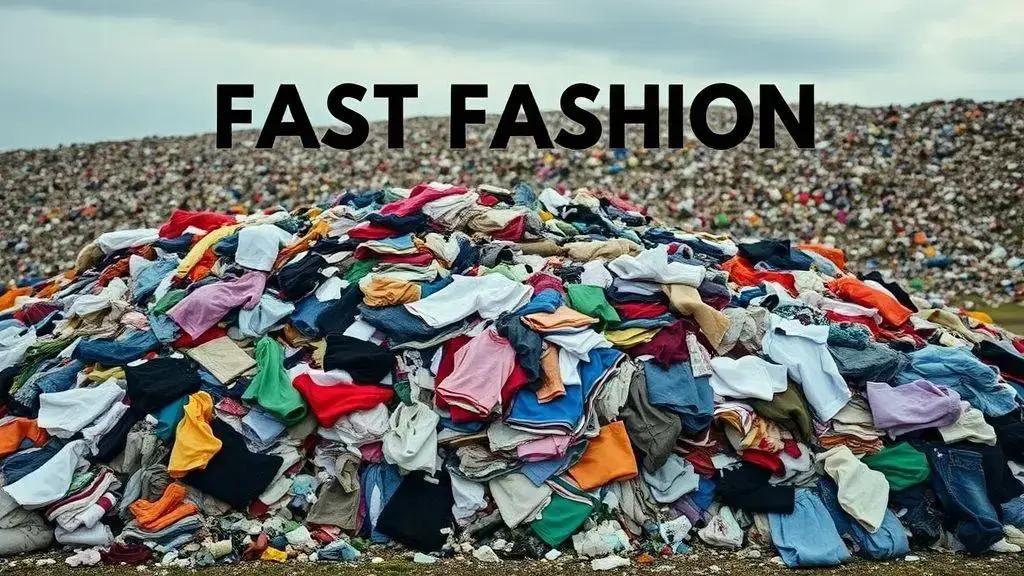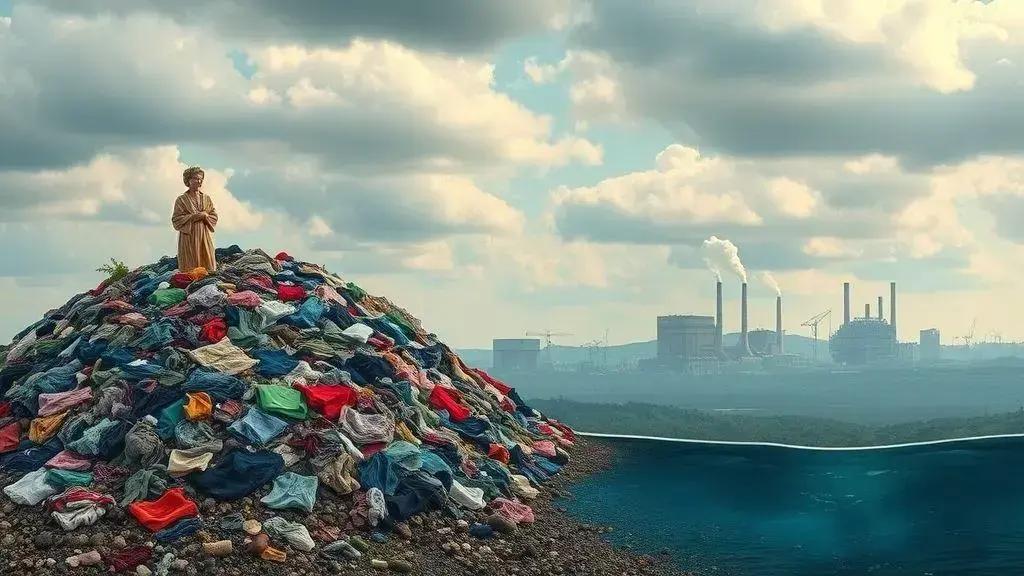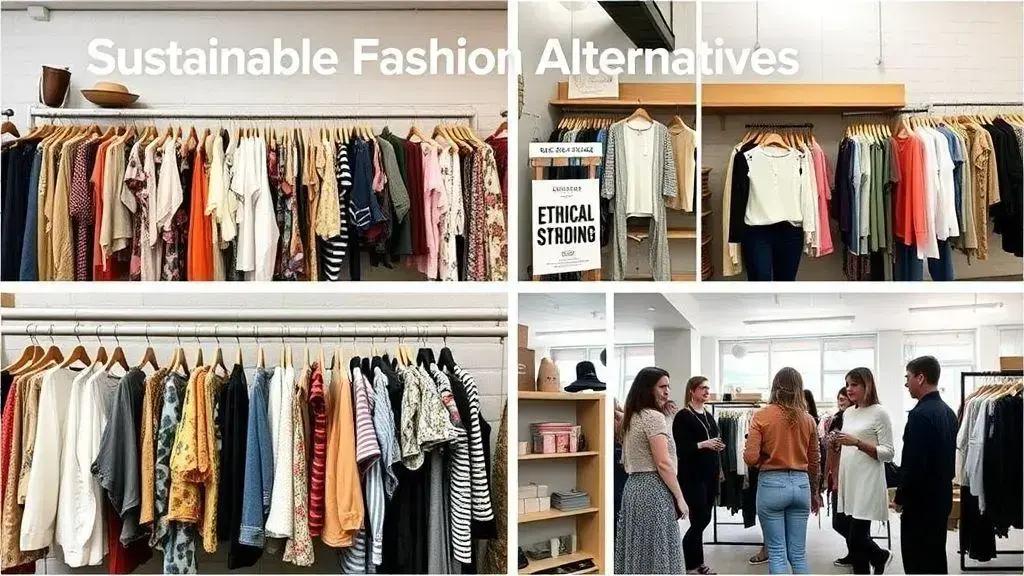In-depth analysis of fast fashion’s impact on society

Understanding the impact of fast fashion reveals significant environmental consequences and social challenges, emphasizing the need for sustainable alternatives like thrift shopping, supporting ethical brands, and upcycling old garments.
In-depth analysis of fast fashion’s impact shows just how deeply this industry affects our world. Have you ever thought about what happens to clothing after you wear it? Let’s uncover the layers behind it.
Understanding fast fashion and its rise
Understanding fast fashion and its rise is crucial in today’s consumer-driven society. Many people enjoy shopping for trendy clothes, but few stop to consider the implications of their purchases. Fast fashion makes it easy and affordable to stay updated with the latest styles. However, this convenience comes with significant costs.
The Birth of Fast Fashion
Fast fashion emerged in the late 20th century as retailers sought to provide consumers with the latest trends at rapid speeds. Major brands began to manufacture garments quickly and inexpensively, often replicating high-fashion designs. This strategy not only catered to consumer demand but also fueled a cycle of constant consumption.
Why It Works
Fast fashion appeals to consumers for several reasons:
- Incredible affordability, making stylish clothing accessible.
- Frequent new collections keep shoppers returning for more.
- The illusion of high fashion without the hefty price tag.
As a result, it is common for individuals to buy clothing without thinking about its lifespan or impact. This phenomenon leads to a culture of disposability—clothes are worn a few times and then discarded.
Brands often market their clothing as “must-haves” or “limited editions,” playing on consumer desire to have the latest items. As you can see, the marketing strategies employed by fast fashion companies encourage frequent purchases without regard for sustainability.
The Role of Social Media
Social media has further escalated the rise of fast fashion. Influencers showcase new outfits daily, and hashtags encourage shoppers to buy the latest trends. Every post creates pressure to keep up, making it easy to fall into a cycle of overconsumption.
Meanwhile, the environmental impact grows. Millions of tons of clothes end up in landfills each year, posing severe ecological challenges. Understanding the implications of fast fashion not only helps consumers make informed choices but also opens the door for more sustainable shopping practices.
By recognizing the issues connected to fast fashion, we can start to shift our habits toward more responsible consumption. Seeking out ethical brands or purchasing secondhand clothing are excellent steps toward reducing this problem.
Environmental consequences of fast fashion

The environmental consequences of fast fashion are alarming and far-reaching. As clothing is produced rapidly and often disposed of quickly, the negative effects on our planet are profound. One of the most significant impacts is the enormous amount of waste generated. Each year, millions of tons of clothing end up in landfills, contributing to pollution and taking decades to decompose.
Water Usage
Fast fashion also demands a staggering amount of water. Producing just one cotton t-shirt can require up to 2,700 liters of water. This excessive water consumption strains local water supplies, particularly in areas already facing scarcity. The cotton farming practices often lead to soil degradation and increased use of pesticides, which further harm the environment.
Carbon Footprint
The carbon footprint associated with the production and transportation of fast fashion is significant:
- Manufacturing processes release large amounts of greenhouse gases.
- Transportation of garments around the globe increases carbon emissions.
- High energy consumption from factories contributes to environmental degradation.
Moreover, many fast fashion brands use synthetic fibers, such as polyester, which are derived from fossil fuels. These materials not only contribute to the depletion of non-renewable resources but also take hundreds of years to break down, causing long-lasting environmental harm.
In addition to the waste and resource depletion, fast fashion leads to water pollution. During the dyeing and finishing processes, toxic chemicals can leak into waterways. This pollution poses serious risks to aquatic life and drinking water sources for communities nearby.
Understanding the environmental consequences of fast fashion is vital for consumers. By recognizing these impacts, individuals can make more informed choices about their clothing purchases and advocate for sustainable practices within the fashion industry.
Social implications of fast fashion
The social implications of fast fashion are complex and wide-reaching. This industry not only shapes consumer habits but also affects communities around the globe. As brands strive to produce cheaper clothing quickly, the effect on workers and societies becomes increasingly concerning.
Labor Conditions
Fast fashion brands often rely on overseas manufacturing, where labor laws may be less stringent. Many factory workers face poor conditions, long hours, and inadequate pay. These issues are particularly acute in developing countries, where workers might earn less than a dollar an hour.
Impact on Local Economies
In many cases, the emergence of fast fashion has altered local economies:
- Traditional artisans struggle to compete with mass-produced items.
- Local businesses face declining sales as people buy cheaper clothing.
- Job security diminishes, leading to economic instability.
This shift results in a loss of cultural heritage as unique craftsmanship gets overshadowed by trendy, inexpensive clothing. Many artisans and small-scale producers find it difficult to sustain their livelihoods in this environment.
Moreover, the disposable nature of fast fashion fosters a throwaway culture among consumers. People often buy clothes with the intent to discard them quickly, reducing the perceived value of garments. This attitude can lead to a lack of appreciation for craftsmanship and quality, further endangering local producers.
The Role of Gender
Fast fashion disproportionately affects women, many of whom make up the majority of the workforce in garment factories. These workers often face additional challenges, such as gender discrimination and lack of access to education and healthcare. Addressing these social issues requires a commitment from brands and consumers alike to advocate for fair treatment and rights.
In conclusion, understanding the social implications of fast fashion is crucial for encouraging ethical consumer behavior. By being aware of the effects on workers and communities, consumers can make more informed choices that support fair trade and responsible practices in the fashion industry.
Alternatives to fast fashion that matter

Finding alternatives to fast fashion that matter is essential for creating a more sustainable fashion future. Many consumers are beginning to recognize the impact of their purchases and are looking for ways to shop ethically. Fortunately, there are several viable options that support both people and the planet.
Thrift Shopping
Thrift shopping has become increasingly popular as a way to find unique clothing items while reducing waste. Shopping at thrift stores allows consumers to:
- Give clothes a second life rather than contributing to landfill waste.
- Discover vintage pieces that offer a distinct style.
- Save money while making sustainable choices.
This practice not only promotes environmental sustainability but also supports local businesses and charities.
Ethical Brands
Another great alternative is to seek out ethical and sustainable fashion brands. These companies prioritize fair labor practices and environmentally friendly materials. Consumers can look for:
- Brands that use organic, recycled, or eco-friendly materials.
- Companies that are transparent about their supply chains.
- Labels that invest in their workers’ wellbeing and fair wages.
By choosing to support these brands, consumers align their values with their purchasing decisions, promoting a fashion industry that cares for its workers and the environment.
Some people also choose to swap clothes with friends or host clothing exchange events. This fun activity allows individuals to refresh their wardrobes without spending money or contributing to overproduction.
DIY and Upcycling
For those with a creative flair, do-it-yourself (DIY) projects and upcycling existing clothing can be both fulfilling and sustainable. Transforming old garments into new pieces can reduce waste and foster creativity. Simple ideas include:
- Turning old jeans into a stylish bag.
- Repurposing t-shirts into unique home decor items.
- Customizing clothes with embroidery or fabric paint.
By taking these steps, consumers can enjoy fashion while making choices that have a positive impact. Understanding that alternatives to fast fashion exist helps to shift the narrative towards responsible consumption, encouraging others to consider their buying habits as well.
FAQ – Frequently Asked Questions about Fast Fashion Alternatives
What are the main issues with fast fashion?
Fast fashion is linked to environmental damage, poor labor conditions, and a throwaway culture that discourages sustainability.
How can I shop more sustainably?
You can shop sustainably by choosing thrift stores, supporting ethical brands, and participating in clothing swaps.
What is upcycling and how can I do it?
Upcycling involves repurposing old clothes into new items. You can turn old jeans into bags or use fabric scraps for home decor.
Why is supporting local artisans important?
Supporting local artisans helps preserve traditional crafts and ensures fair wages, contributing to a more sustainable economy.





